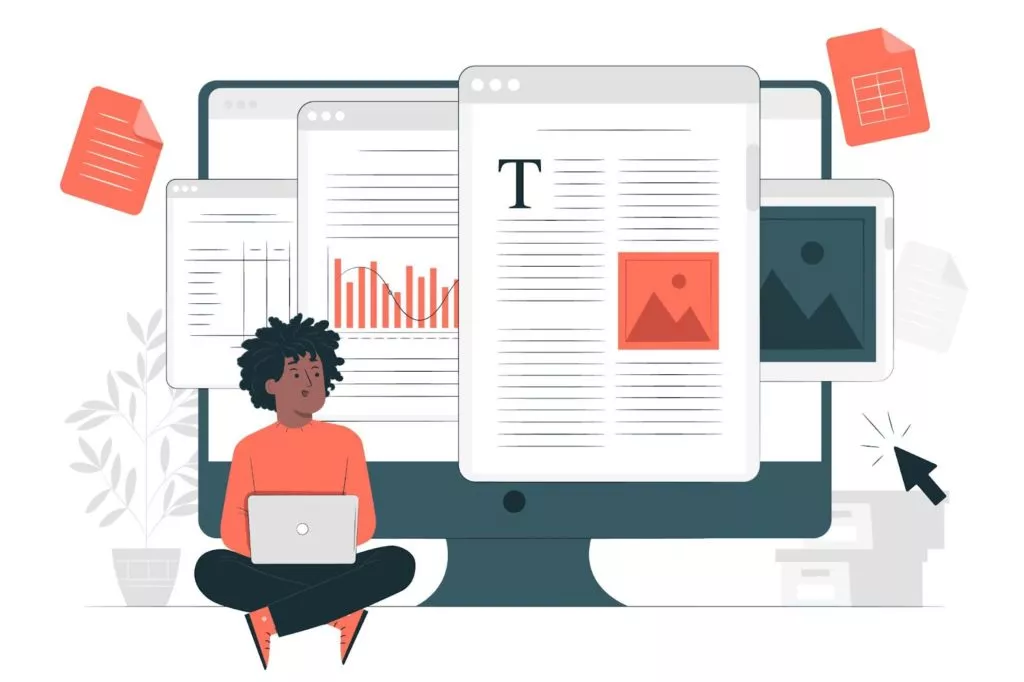
Repurposing your content not only brings you more engagement from the posts you make but also enhances its distribution. However, it’s essential to note that merely copying and pasting content from your website to social media is not content repurposing.
Instead, the right way to reclaim evergreen content is to pinch it to satisfy the anticipations of every marketing channel. Want to know how to pinch more worth from the quality content you have been making?
Scroll on to learn how to determine what content to repurpose. Dive in.
What is repurposing content?
Repurposing content involves taking your old, classic content and employing it as a starting point for new content in fresh formats.
That does not indicate just copying your content from one form to another. In other words, reading your blog content out loud to provide audio content is not adequate.
Instead, you repurpose content by carrying the original content and searching for new ways to demonstrate the ideas, utilizing audio, video, or social media to provide the product details to your clients.
When you repurpose your content for unique formats, you will most probably have to modify, revise, or add to the blog content to produce top-quality content that delivers genuine value.
This data is brand new for new consumers, but existing clients have already noticed the content in one form.
Instead, repurposed content is another method of encountering them and restoring the content to its senses. All of this is optimized to emerge at the top of the search results for your keywords.
Why should you repurpose content?
What are the advantages of repurposing your old blog content? Repurposing provides numerous benefits for your business and your users.
Forty-six percent of marketers discover repurposing content more effective than producing new content, and 65 percent believe it is more cost-friendly than minor updates or new content.
Advantages you should consider:
- Repurposing your content makes it more comfortable to grow. Each part of refreshed content you create can be allocated to your audience in various forms.
- Your content appeals to a fresh audience. Target audience members who don’t desire to read content may like to listen to, watch, or download a video or a podcast.
- Repurposing content strengthens your message. If your users have read your blog post and listened to a podcast on the same subject, they understand the details nicely.
- Your repurposed content provides your business with enhanced organic visibility.
- Repurposed content enhances your SEO.
Identify your best-performing content
When you begin, the most helpful content to repurpose is your best-performing piece. Why must you start there? Top-performing content in written format will probably translate into top-performing content in other forms. It’s not guaranteed, but it’s an acceptable way to begin.
See your analytics to discover your top-performing content. Typically, the top-performing content is evergreen. But that’s not a difficult and quick rule. Your great-performing content may be seasonal.
Understand your target audience
Don’t think that your target users are precisely identical for every format when you’re repurposing content. Individuals understand better in various ways, and younger users are more inclined to more recent formats.
The scope of demographics for every kind of format overlaps but is distinctly different.
To discover your most excellent performing content, see your content’s analytics. Look for contents that rank for shares, organic visibility, connecting structure, and other performance statistics.
Other methods to discover posts to repurpose are:
- Read your current reviews.
- Analysis of competitors’ posts.
- See which posts reach more user engagement.
- Repurpose each of your new posts.
Repurposing content tips
Now that you have chosen which content to repurpose, are you uncertain about what to do now? Here are a few suggestions to help you begin making high-quality content.
Create new formats
Repurposing posts works quite nicely when you make new formats. Suggestions of formats include:
- Social media posts
- Slide show/presentations
- Videos
- Infographics
- FAQ
- Podcasts
- Whitepapers
- Case studies
- Testimonials
- Landing pages
- Online courses
Update old content with new information
Your post would be most helpful to the audience if it were updated. Constantly updating your current post makes it more helpful to buyers.
The most straightforward way to update posts is by adding new details appropriate to the subject. This can be details found after the initial issue date or expanding your range on the subject to be more in-depth.
Repurposing old posts is most beneficial for updating the older content.
Turn long-form content into shorter pieces
The website audience does not always read long-form blog content. Individuals frequently watch longer content. One way to gain more attraction in long-form posts is to cut it into more concise pieces.
This works nicely with publishing content on video sites, social media platforms, or slide shows.
Create a series of related content
Discover or create related content and deliver it in a series. Think of it as a series of videos, chapters in a book, or podcasts.
Shorter content is adequate for maintaining the buyer’s attention. Connecting the series will rush traffic from one content to the next.
Repurpose social media content into blog posts
It is straightforward to display turning blog posts into social media posts, but what about vice-versa?
If you’ve social media content that gets good engagement, why not modify it into new kinds of blog posts?
Connecting your social media content to your blog posts will push traffic to your blog.
Collaborate with others to create new content
The most straightforward example of conspiracy is an interview. Invite professionals to share their experiences to add depth to your posts.
This format performs nicely with podcasts as you can hear more than one voice, but you can unite with others to make most kinds of content, from demonstration videos to FAQs.
Conclusion
Content repurposing is not only about reclaiming old material; it is a systematic process to maximize the effect of your current content and boost its reach to accomplish a more significant marketing victory.
As you can see, there are several useful methods for modifying your pieces into other forms of content. While the concept is easy, distributing and repurposing content requires plenty of time and deliberate effort.
FAQS
What is the most excellent tool for repurposed content?
Canva is a favorably adaptable tool for post-repurposing. Modify existing content into dozens of unique pieces over various other formats, including social media graphics, ebooks, infographics, presentations, and more.
How do you repurpose viral content?
Among the easiest ways to repurpose your posts is to repost them on other media. Repost your art on platforms appropriate to your goals, users, and niche.
What is the power of repurposing content?
Your repurposed posts should still be helpful and applicable to your users. Repurposing content is a robust method that can save resources and time, reach fresh audiences, and support your brand message.



